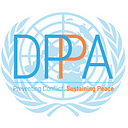More than Pretty Pictures: Harnessing the Full Potential of Data Visualization
Modern information technology has the potential to deeply transform the work of peace and security practitioners, be they mediators, peacekeepers, policy-makers or analysts. Advances in data collection, analysis and visualization techniques in particular offer novel ways to approach crisis and conflict situations, contributing to a better identification of patterns and trends and to informed action where peace is compromised. The United Nations, including its Department of Political and Peacebuilding Affairs (DPPA), is actively exploring and adopting these new techniques as it confronts a complex rapidly evolving conflict environment.
Potential in the Peace and Security Space
From satellite imagery to forensic inquiries to machine learning techniques applied on radio or social media content, the use of technology in the peace and security space holds great promise. The benefits of these new tools are clear. They can help expand situational awareness, which is particularly useful in settings with limited access to analysts. They also help uncover surprising correlations, patterns and political trends, which is especially useful in improving early warning and analysis. And they are useful in building and assessing scenarios.
It is no wonder, then, that data visualization and analysis has seen such growth within the United Nations, as well as within international organizations and non-governmental groups more broadly. The array of opportunities and some use-cases of ongoing UN projects have been described in this guide, produced recently by the DPPA with Global Pulse and UN University.
But how does one integrate data-related activities effectively in the work of peace and security practitioners? What does it entail to work with data, and to what extent does it affect current practices?
“This is obvious to most but it bears repeating: no useful information can be derived from a single data point,” said Pauline Gourlet, Data and Innovation Lead at DPPA. “Contextual elements are essential. Data cannot be understood outside of the process in which it is embedded, from its collection to the epistemology underlying the models used for its analysis. Moreover, anything can potentially be considered as data; it all depends of the question being asked.”
Indeed, data always has to be understood as part of a complex sense-making process. “To make relevant use of data, it is critical to first make explicit a leading question or problem that will frame the context of the inquiry and help design an appropriate research process”, Gourlet said.
Data Activities: a comprehensive framework
Three main concerns drive data activities: How are data collected? How should it be analysed? And how to best present the findings?
Collecting data raises ethical issues (privacy, ownership, etc.) on top of technical ones (structuration, storage, security, etc.), for which the United Nations recently provided guidance. Often overlooked and limited to its technical dimensions, collection processes can actually prove essential for peace efforts, especially for trust building and mediation processes (see for example, the case of environmental assessment in Ogoniland, Nigeria).
Data analysis consists of reading the data in the light of the question or problem one is trying to answer, testing out different hypotheses, applying different models or displaying the data using different representations. The tools and processes can greatly vary, from basic descriptive and statistical models to more complex algorithms. Data visualization techniques help make sense of the data using different ways of representing a same data set.
Early in the process, it is also important to know how the results will be communicated to others. The outcomes can be of different nature (a report, a political statement, a social media post, a data-driven article, etc.), their designs are nonetheless driven by two main questions: what are the goals and who is the audience.
These three dimensions — data collection, analysis and communication — are often thought of as separate activities, conducted by different actors in a chronological order. In fact, they’re interdependent, forming a comprehensive data cycle.
In that regard, interactive data visualization can be designed to serve as bridging interfaces. Indeed, they can be used to efficiently collect data and analyse datasets while communicating insights or results in a compelling way.
DPPA is currently testing such processes. “For example, to better understand opinions and perceptions on social media, we are designing a user-friendly interface that queries the Twitter API and, thanks to basic machine learning techniques, automatically generates a data-driven report,” Gourlet said (see image on the right). “This visual outcome gives a snapshot of the ongoing discussions on Twitter and shows how topics are spread across different groups. Therefore, in a seamless way, such interface enables to parameter and collect a dataset, to conduct analyses and communicate the results: taking advantages of automation with a human-centered approach, it bridges tasks and workflows in an efficient manner.”
Culture Shift Needed
“What is evident with these technological advances, their potential and their risks, is the requirement for us to operate differently.” António Guterres, UN Secretary-General
For peace and security practitioners, integrating this framework has important consequences, requiring a major shift in the way of working. Such a transition goes far beyond a simple change of tools or technologies and cannot be limited to the technical realm. It has an impact on organizational culture as it completely transforms the relations to information, both at individual and collective levels.
“As with any transition, these changes require time, perseverance and care. The ongoing reform of the UN’s peace and security structures presents an opportunity in this regard” Gourlet added. “And we refer to human-centered design approaches that are powerful instruments of change.”
Toward a Community of Practice
Note: A collaborative collection of references and data-related projects can be found here: http://www.lopendoc.org/dataculture/
